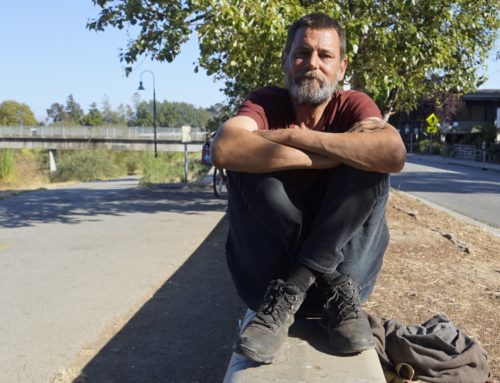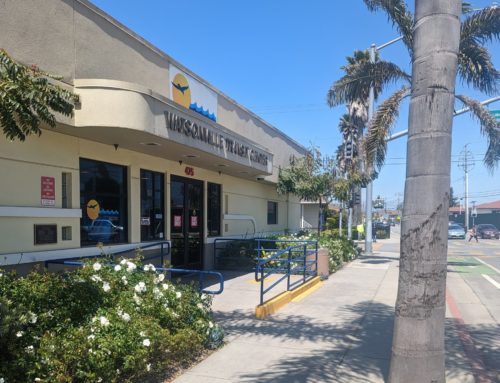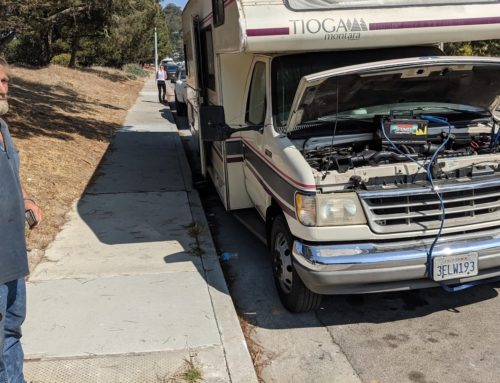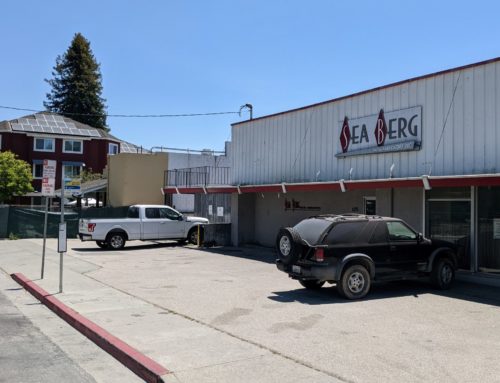The COVID-19 pandemic has exposed a need for mental health services in Santa Cruz County’s public schools. We hear from a director at the Santa Cruz County Office of Education about virtual mentoring, an approach that has shown promise in addressing student mental health needs. We discuss how it works and where it falls short. This episode is the third in Santa Cruz Local’s Distance Learning Series. Transcript below.
Takeaways
What approaches have shown promise in addressing students’ mental health needs during the pandemic?
Santa Cruz Local asked Michael Paynter, senior director of student support services at the Santa Cruz County Office of Education. That division often serves the most vulnerable students in the county, including students who are homeless or in foster care.
- Virtual mentoring has shown promise: Students are paired with case managers who meet with them individually online each week. They provide some social work and emotional support. They also check in on classwork. Program leaders have reported that participants have attended school more, Paynter said.
- Home visits are another approach: Pairs of social workers and school staff knock on doors of students who have not been showing up for class. They ask students what they need to engage in school: Wi-Fi, food access, counseling or other services.
What are some shortcomings of these approaches?
- Sometimes, virtual mentoring, professional counseling and home visits are not enough to get some students back in the online classroom, Paynter said. “That is a huge shortcoming. We don’t know what to do at this point,” Paynter said.
Are you a student in need of mental health services?
- Call or text 211 to connect to a provider.
- Call Pajaro Valley Prevention and Student Assistance at 831-728-6445.
- Call Encompass, which offers free counseling to families on Medi-Cal. 831-429-8350.
- Anyone who is contemplating suicide or has lost someone to suicide can call the National Suicide Prevention Lifeline at 800-273-8255.
Santa Cruz Local’s Distance Learning Series
Our podcast series focuses on distance learning and the state of public education in Santa Cruz County. We focus on the themes we hear from you. Read the transcript or listen to the episodes.
- Public education money, COVID and the power of Santa Cruz County school boards (Jan. 31, 2021)
- Student mental health and stress in Santa Cruz County, part 1 (March 23, 2021)
- Student mental health and stress in Santa Cruz County, part 2 (March 26, 2021)
We want to hear about your priorities and concerns with public education in Santa Cruz County. Take Santa Cruz Local’s three-minute survey. Your feedback informs this series.
Transcript
Advertisement: Investing doesn’t have to be complicated. Talk to the experienced professionals at WI Investment Advisory Group. Visit them at 1535 Seabright Avenue, Suite 110 in Santa Cruz.
They are Registered Representatives and Investment Adviser Representatives with / and offer securities and advisory services through Commonwealth Financial Network, Member FINRA/SIPC, a Registered Investment Adviser.
WI Investment Advisory Group, Investing for What’s Important. wiiag dot com
[THEME MUSIC]
KARA MEYBERG GUZMAN: I’m Kara Meyberg Guzman.
This is Santa Cruz Local.
The COVID-19 pandemic has exposed a need for mental health services in Santa Cruz County’s public schools.
In our interviews with students and families, a constant theme has been the stress of distance learning. Many county residents have told us that they need help and services, especially during the pandemic.
This episode is the third in a series about distance learning and the state of public education in Santa Cruz County. We’ll not only look at the problems, but also shine a light on what’s working.
Today we’ll hear from Michael Paynter. He works at the Santa Cruz County Office of Education. He is the senior director of student support services. That division runs programs that often serve the most vulnerable students in the county. That includes students who are homeless, in foster care, or at risk of entering the court system.
I asked Michael about student stress and mental health.
MICHAEL PAYNTER: I guarantee you that every single school district at every level, right, from the frontline teacher and teacher’s aide to the superintendent is thinking about this, right? So I know that this is at the top of their list. And I appreciate and applaud that.
Social emotional learning and mental health supports has always been a little bit of an add on, an extra. And I think that everybody involved is now seeing that it is crucial, it is essential, and it is, in fact, foundational to do good subject matter learning and teaching.
And so that’s that’s the hope, but it does sort of speak to what you said, which is there is a lot — hundreds, I would say hundreds and hundreds of kids that are struggling in this way.

Michael Paynter, senior director of student support services for the Santa Cruz County Office of Education, was interviewed by Santa Cruz Local’s Kara Meyberg Guzman on Feb. 9, 2021. (Zoom screenshot)
KMG: Michael leads the division of student support services. That division offers mental health services. They also try to address truancy. They work with students in local public schools, and in alternative education.
Alternative education is individual and small group instruction for kids who have trouble with traditional school settings. Those students are referred to alternative education. They can be referred by their school district, an attendance review board, the county probation department, or others.
I asked Michael to describe what he’s seeing as far as student mental health needs and stress during distance learning.
MICHAEL PAYNTER: Yeah, you know, I would almost reframe it a little bit, that I think some of the issues right, are, were pre-existing. And again, given my sort of program focus, right, I think we’ve seen a lot of students for many years struggle with sort of engagement, and, you know, attention, attendance, anxiety, depression, all kinds of issues. And largely, I think they sort of get funneled into different pockets that maybe serve them in a better way, right. And that’s really what alternative education has done for years and years.
I think the interesting thing about the pandemic is that it has increased the students who are experiencing those symptoms, right, especially like you noted, in the mental health realm with anxiety and some depression.
But also, I think it’s put a spotlight on it by the parents, right? So I don’t know that parents were really as attuned to the sort of hourly shifts in their own child’s moods, so to speak, related to education. I’m sure they were in other realms, but because they went to school, and the school staff and adults really attended to those hours.
And so, you know, I had a note somewhere that if there is a silver lining, and there probably are some silver linings to this, this incredible journey, this process, this kind of horrendous process, in a lot of ways. I think, one, it’s that all of the adults that surround students — from the parents to the school staff, right to agency and community partners — really keep I should say, keep this as this meaning the mental health focus, the social, emotional, sort of intelligence and health of students at the forefront of everything.
KMG: I asked Michael to share some of the approaches in the last year that have shown some promise in addressing mental health needs of students.
He told me about programs at the county office of education that often work with kids in foster care, homeless students and those at risk of entering the court system.
MICHAEL PAYNTER: What we have found has been very helpful is what we’re calling basically virtual mentoring. So every single week, they have case managers, right. And we call them mentors or case managers, and they log on and it’s often just lots of communication by text and then an actual appointment, virtually.
And half of it really is support and counseling, and half of it is helping them walk through, what is your assignment? What did you need to log on? What happened in class? Why didn’t you want to go? And most of these students have risen to the top of folks that were starting to be disengaged virtually, right. And that number was increasing. And so that’s one thing that we think has worked well.
And in fact, in some ways, it’s been able to happen more often virtually, because in person, there was a lot of traveling around the county, you know, to meet students. And so that’s been really good.
And then ultimately, I know, a number of districts are doing home visits. So if that’s not catching, I know Santa Cruz city, for instance, and Pajaro Valley, the biggest ones for sure, are sending social workers in pairs, right? So it’s a social worker and somebody else, and they’re knocking on doors. And when they do it, it’s all supportive. It’s “Oh, do you need Wi-Fi? Do you need food? Do you? Do you need counseling? How? What is it that you need, we’re here to help you log on and get engaged with your education.”
KMG: Got it. Thank you, Michael. My goal with this series is to really shine a light on what’s working, and really like, break down how it works. What are your sort of measures of success? How do you know it is working?
MICHAEL PAYNTER: I think the ultimate measure right now is are they re-engaging into their distance learning curriculum and schedule. I do know that they are keeping track of that for the mentoring and the mentoring is showing increase both in attendance and grades. And they feel like participation.
Because sometimes there’s also different levels. I’m sure you’ve heard, right. It’s one thing to show up for a class and have your screen blacked out, never say anything, never turn on your camera, right? Versus like I’m turning on the camera. I’m asking a question. I’m answering your question. Right? I’m making eye contact. Right. So even that level of engagement is important, the differentiation there.
KMG: I followed up with Michael afterwards to ask for data on school attendance among those who get virtual mentoring. He told me he didn’t have hard numbers on school attendance and program participation. So, we don’t know for sure if there’s a correlation.
But, Michael told me he’s heard stories and reports from the program staff that their participants have been attending school more.
Students who are in foster care or who have been truant automatically get virtual mentoring. So do students who are in a program that diverts kids from the court system. Other than those groups, it’s really up to the school districts and the county alternative education program to identify and refer kids who need virtual mentoring.
Virtual mentoring is one of several mental health programs connected with the schools.
There’s also professional counseling. It’s for students with deeper needs, like anxiety, depression, trauma. It’s a deeper level of service than virtual mentoring. Unlike virtual mentoring, the counseling is administered by licensed professionals. They’re employed by school districts or nonprofit partners. And during the pandemic, a lot of this counseling has been done over the phone or online.
I asked Michael who might be falling through the cracks. Which students need help, but can’t be reached by virtual mentoring, professional counseling or home visits?
MICHAEL PAYNTER: Yeah, I mean, we have been hearing stories where — again, the sort of last, I guess, intervention tool we have is literally to go to the home, right, and knock on the door, sometimes multiple times. And we have some stories of people who, like we know they’re home, and they will not answer the door.
And so then it becomes, if we have extenuating circumstances, like we know, we have a suicidal student, or we know there could be a danger to others because of something in the family, then we can pull in law enforcement, and they can knock on the door, obviously, with more power.
But in general, it doesn’t escalate to law enforcement just because they’re not attending or answering the school knocks. And so there are, I mean, I believe we probably could make a list by addresses because they have tried, right? So they know where they live and who they are. There is a group of students who is not responding to any of these tools that I mentioned.
So that is a huge shortcoming. We don’t know what to do at this point. And then there is something called the Student Attendance Review Board which escalates some of these students. It used to be in person where if you didn’t come to school, you had a certain amount of absences, you would get letters sent home, and then eventually, you know, you come in front of a board. And ultimately, you can actually go to truancy mediation right, in front of a judge. And the DA [district attorney] could in fact file charges.
One of the shortcomings is that districts, again, do their filtering. Sometimes they call them District Attendance Review Boards, “DARBs,” or different names. And then they get to their true SARB [School Attendance Review Board]. And there’s three of them. There’s one in Pajaro Valley, one in Santa Cruz city and one for every other district that the [county office of education] runs. And they have a virtual format. And I know some have been quite successful.
But right now, there’s really no next level. And so what we’ve, you know, heard from the sort of, I guess, juvenile justice system really is, there’s not another piece they can offer that is different than the SARB we’re already doing. And so right now, again, like the knock on the door, if they’re not responding to that virtual SARB, it’s another group of kids that is sort of not being captured, and that again, is going to need a lot of follow up.
KMG: Do you know of any other communities that have found an alternative way like, you know, a next level, beyond the SARB?
MICHAEL PAYNTER: Um, this, this gets very complicated and philosophical. And you know, so I’m pausing for a second. But so there are other communities that have a little more teeth, right. And so I think as a community, there would have to be a decision and a discussion around how much quote unquote “criminality” do you include in the attendance process for schools. And Santa Cruz County, right has really erred on the side of being supportive, social work oriented, case management oriented, right, with lots of chances and lots of rallying community partners. And in general, I think it works pretty good.
I know other counties nearby, take a different approach and have a very strong probation and district attorneys partnership, where they are able to find parents, right, restrict licenses, you know, bring people into court, and we had just as a community have not decided to go that route. And that would be a different path. It likely would get attention from some of these folks that were that we’re talking about. But I think again, that’s a larger philosophical community discussion that would have to happen from multiple agencies.
KMG: Yeah, understood. Yeah. Thank you, Michael. Is there anything else we didn’t cover that you’d really want students, parents and educators who are listening to hear?
MICHAEL PAYNTER: I think there’s an increasing amount of community partnerships that’s occurring. And they — So I think one positive that can come out: County Behavioral Health just launched a mobile emergency response for youth van, right? And, and so that’s an example of our community partnerships being able to go to schools. Because a lot of the issue historically has been, in theory, there is help for all of these students in the county. But there’s something that breaks down between them needing it and getting to it.
And so the more that we can infuse, I think, the County Behavioral Health, the Encompass, the PVPSAs, the Family Service Agency, the Healing Survivor Center, you name it, like, all of these amazing agencies that exist in our county, how can they show up in our school system in a way that is more integrated?
And I think, you know, there’s edges on both sides, it’s not that they’re not interested. Schools sometimes can be closed systems as well. I think that we will be all the better for it. Because schools and staff while we do need to change the individual, I think, mindset, we also can’t do everything. And there are lots of professionals and great partners that can do a lot of this work if we can somehow infuse and embed them into our system better. And I think you’ll have a lot more access and a lot more support than sending them out to somewhere else.
KMG: Michael mentioned PVPSA, or Pajaro Valley Prevention and Student Assistance. They are a nonprofit group based in Watsonville. They provide professional counseling and other mental health services to students in the Pajaro Valley Unified School District.
I recently interviewed the Pajaro Valley Prevention and Student Assistance CEO, Erica Padilla-Chavez. You’ll hear from her in an upcoming episode. Erica told me that one of their keys to success is their 30 years of experience working with the school district. PVPSA was designed from Day 1 to work with Pajaro Valley Unified School District. Erica put it this way: PVPSA and the school district know how to dance well together, because they’ve perfected their rhythm over the last three decades.
I asked Michael if there was a North County equivalent of PVPSA.
MICHAEL PAYNTER: That is a very good question. And there’s not exactly. And I’ve been thinking a lot about this and, you know, Erica Padilla-Chavez, who’s the CEO of PVPSA is an amazing woman. And I’ve talked to her about that. And, you know, Encompass in some ways could be that, but I think the complication is that PVPSA originally was formed as a dedicated nonprofit to PVUSD. And PVUSD has half of all students in the county. And so in some ways, there’s an easy one nonprofit, one school district, 20,000 kids.
And when you come into North County, what you end up having is 10 school districts if you count alternative [education], right. And then you have multiple nonprofits. And so there’s just a lot more moving parts. But it is something under this “SIBHI” — Schools Integrated Behavioral Health Initiative — that we are looking at is, how do we create a more simple direct pipeline of support and services. Because there is a lot of upside to that simplicity of that connection.
[MUSIC]
KMG: Are you in need of mental health services? We’ll post some local resources in the show notes. You can also call or text 211 to get connected to a provider. You can also call Pajaro Valley Prevention and Student Assistance, even if you’re not a student of Pajaro Valley Unified School District. Their number is 831-728-6445.
Encompass, a nonprofit group in Santa Cruz, also offers counseling to young people and their families. There is no cost for families on Medi-Cal. Call 831-429-8350.
Anyone who is contemplating suicide or has lost someone to suicide can call the National Suicide Prevention Lifeline at 800-273-TALK (8255).
Stay tuned for the next few episodes in this series on distance learning and the state of public education in Santa Cruz County. We’ll hear from others who are trying to address student mental health during the pandemic.
We’ll hear about approaches that have shown promise: how they work and where they fall short.
[MUSIC]
KMG: Thank you to our Santa Cruz Local members. Our members allow our work to be free for all.
Thank you especially to our highest-level members:
- Elizabeth and David Doolin
- Fran Goodwin
- Debra Szeicei
- Chris Neklason
- Patrick Reilly
- Elena Cohen and Steve Ritz
Become a member and support local news at santacruzlocal.org/ membership.
And. If you’re not on our email newsletter yet, it’s time to join. That’s where you can learn more about what’s happening in local government and how to make your voice heard. We’re in your inbox two to three times a week. Sign up link is in the show notes.
Thanks to Trimpot for the music.
I’m Kara Meyberg Guzman.
Thanks for listening to Santa Cruz Local.
Kara Meyberg Guzman is the CEO and co-founder of Santa Cruz Local. Prior to Santa Cruz Local, she served as the Santa Cruz Sentinel’s managing editor. She has a biology degree from Stanford University and lives in Santa Cruz.





